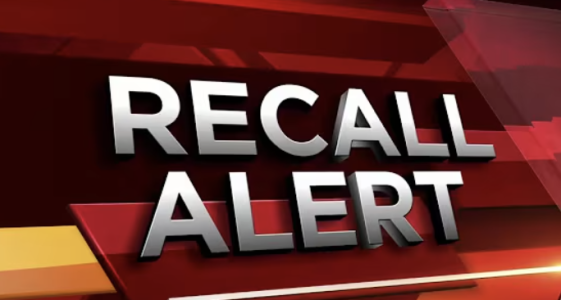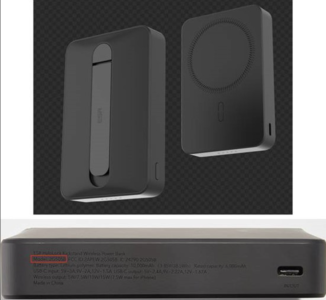A popular charger sold at major stores has been recalled—here’s why it matters
By
Veronica E.
- Replies 0
Many of us rely on portable chargers to keep our devices powered up throughout the day.
They're convenient, lightweight, and often feel like must-have travel companions.
But one popular power bank sold at major retailers has just been recalled over serious safety concerns.
With more than 30,000 units affected across the US and Canada and multiple reports of fires and explosions, it’s a reminder that not all gadgets are as harmless as they seem.
If you’ve purchased a charger online or from a home improvement store in the last two years, it may be worth a closer look.

The recall, issued August 14, 2025, involves about 24,000 ESR HaloLock wireless power banks in the US and nearly 10,000 more in Canada.
The lithium-ion batteries inside these devices can overheat and ignite, posing a risk of fire or burns.
So far, nine incidents have been reported—including explosions that caused around $20,000 in property damage.
Fortunately, no injuries have been confirmed.
The recalled models—numbers 2G520, 2G505B, and 2G512B—were sold between September 2023 and July 2025 for $32–$40 through Amazon, Home Depot, and Esrtech.com.
They come in dark blue, light blue, gray, white, and black, with “ESR” printed on the back and five circular LED indicator lights on one side.
Distributor Waymeet Limited of Hong Kong oversaw sales, with the products manufactured in China.
If you own one of these recalled chargers, here’s what to do:
Lithium-ion batteries are everywhere—phones, laptops, tablets, cameras, and portable chargers.
They’re efficient and rechargeable, but they can be volatile if damaged or poorly manufactured.
That’s why regulators and airlines enforce strict safety rules.
If you’re flying:

Even if your charger isn’t part of this recall, it’s smart to take precautions:
Recalls are often precautionary, but they should be taken seriously.
Read the recall notice carefully, follow instructions for a refund, and don’t donate or pass on recalled devices.
Since these power banks use lithium-ion technology, proper disposal is especially important to reduce fire risks.
This isn’t the only consumer product pulled from shelves recently.
A carbonation bottle sold at Walmart, Target, and Home Depot was also recalled due to explosion risks.
If you’ve bought electronics or appliances in the last year, it’s wise to double-check for safety alerts.
Staying plugged in shouldn’t come at the cost of safety, and recalls like this serve as an important reminder to be cautious with everyday devices.
By checking your gadgets, following recall instructions, and disposing of batteries properly, you can protect both your home and your family.
And if you’ve ever dealt with a recall before, sharing your experience might just help someone else stay safe too.
Read next: FDA announces food recall affecting multiple Dollar General products

Have you ever had to return a gadget you used daily? Did you know about the special disposal rules for lithium-ion batteries? Your story could help another GrayVine reader avoid a dangerous situation. Share your experience in the comments—we’d love to hear how you handled it!
They're convenient, lightweight, and often feel like must-have travel companions.
But one popular power bank sold at major retailers has just been recalled over serious safety concerns.
With more than 30,000 units affected across the US and Canada and multiple reports of fires and explosions, it’s a reminder that not all gadgets are as harmless as they seem.
If you’ve purchased a charger online or from a home improvement store in the last two years, it may be worth a closer look.

Many portable chargers are being recalled after reports of overheating and fire hazards. Image Source: YouTube / KSAT 12.
What’s behind the urgent recall?
The recall, issued August 14, 2025, involves about 24,000 ESR HaloLock wireless power banks in the US and nearly 10,000 more in Canada.
The lithium-ion batteries inside these devices can overheat and ignite, posing a risk of fire or burns.
So far, nine incidents have been reported—including explosions that caused around $20,000 in property damage.
Fortunately, no injuries have been confirmed.
The recalled models—numbers 2G520, 2G505B, and 2G512B—were sold between September 2023 and July 2025 for $32–$40 through Amazon, Home Depot, and Esrtech.com.
They come in dark blue, light blue, gray, white, and black, with “ESR” printed on the back and five circular LED indicator lights on one side.
Distributor Waymeet Limited of Hong Kong oversaw sales, with the products manufactured in China.
Also read: Nationwide recall for a popular deodorant—could yours be among them?
What to do if you have one
If you own one of these recalled chargers, here’s what to do:
- Stop using it immediately. Do not attempt to charge it or plug it in.
- Mark it. Write “Recalled” on the device with a permanent marker.
- Take a photo. Include the model number in the picture.
- Contact Waymeet. Email [email protected] with your photo and order number (if available) to arrange a refund.
- Dispose of it properly. Do not throw it in household trash, recycling bins, or battery drop-off boxes. Instead, follow your municipality’s hazardous waste rules or check with your local HHW collection center.
Also read: Anker recalls over 1 million portable chargers after fire hazard reports—here’s what to do if you own one
Why lithium-ion batteries are tricky
Lithium-ion batteries are everywhere—phones, laptops, tablets, cameras, and portable chargers.
They’re efficient and rechargeable, but they can be volatile if damaged or poorly manufactured.
That’s why regulators and airlines enforce strict safety rules.
If you’re flying:
- Always keep lithium-ion batteries in your carry-on. Never pack them in checked luggage.
- Applies to all devices—phones, cameras, laptops, and power banks.
- Spare batteries must also travel in your carry-on.

The ESR HaloLock wireless power bank recall affects more than 30,000 units across North America due to fire and explosion risks. Image Source: United States Consumer Product Safety Commission.
Also read: Are you using one of these popular chargers? Find out if your power bank is a hidden fire risk!
Stay safe with your gadgets
Even if your charger isn’t part of this recall, it’s smart to take precautions:
- Buy from trusted brands and sellers.
- Check the CPSC website for recall notices.
- Stop using devices with swollen or damaged batteries.
- Store electronics in cool, dry places.
- Dispose of batteries safely at designated collection sites.
Also read: Sweet treat recall issued across 20 states—check your pantry
What if you’re affected?
Recalls are often precautionary, but they should be taken seriously.
Read the recall notice carefully, follow instructions for a refund, and don’t donate or pass on recalled devices.
Since these power banks use lithium-ion technology, proper disposal is especially important to reduce fire risks.
Also read: Popular kitchen item recalled after reports of explosions
Other recalls making headlines
This isn’t the only consumer product pulled from shelves recently.
A carbonation bottle sold at Walmart, Target, and Home Depot was also recalled due to explosion risks.
If you’ve bought electronics or appliances in the last year, it’s wise to double-check for safety alerts.
Staying plugged in shouldn’t come at the cost of safety, and recalls like this serve as an important reminder to be cautious with everyday devices.
By checking your gadgets, following recall instructions, and disposing of batteries properly, you can protect both your home and your family.
And if you’ve ever dealt with a recall before, sharing your experience might just help someone else stay safe too.
Read next: FDA announces food recall affecting multiple Dollar General products
Key Takeaways
- About 24,000 ESR HaloLock wireless power banks in the US and 9,900 in Canada were recalled on August 14, 2025, due to fire and burn hazards.
- The affected models (2G520, 2G505B, 2G512B) were sold at Amazon, Home Depot, and Esrtech.com between September 2023 and July 2025.
- Consumers should stop using the devices, label them “Recalled,” contact Waymeet at [email protected] for a refund, and dispose of them at hazardous waste centers.
- Nine incidents of fires and explosions have been reported, causing $20,000 in property damage, though no injuries.
Have you ever had to return a gadget you used daily? Did you know about the special disposal rules for lithium-ion batteries? Your story could help another GrayVine reader avoid a dangerous situation. Share your experience in the comments—we’d love to hear how you handled it!






